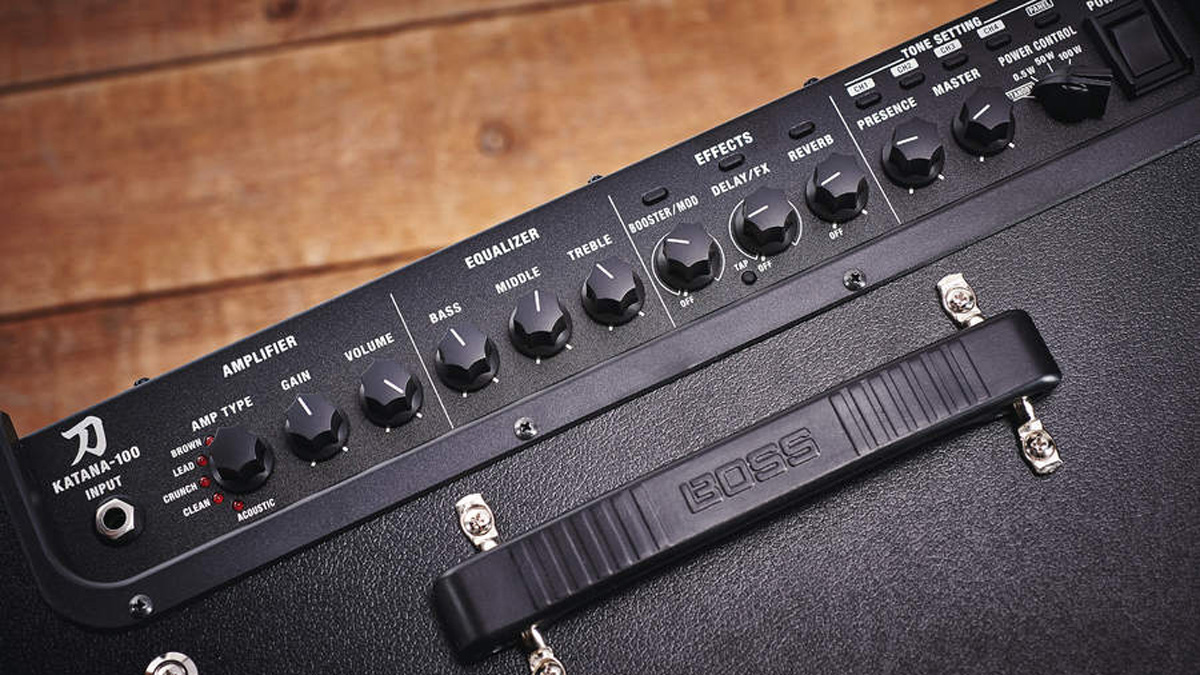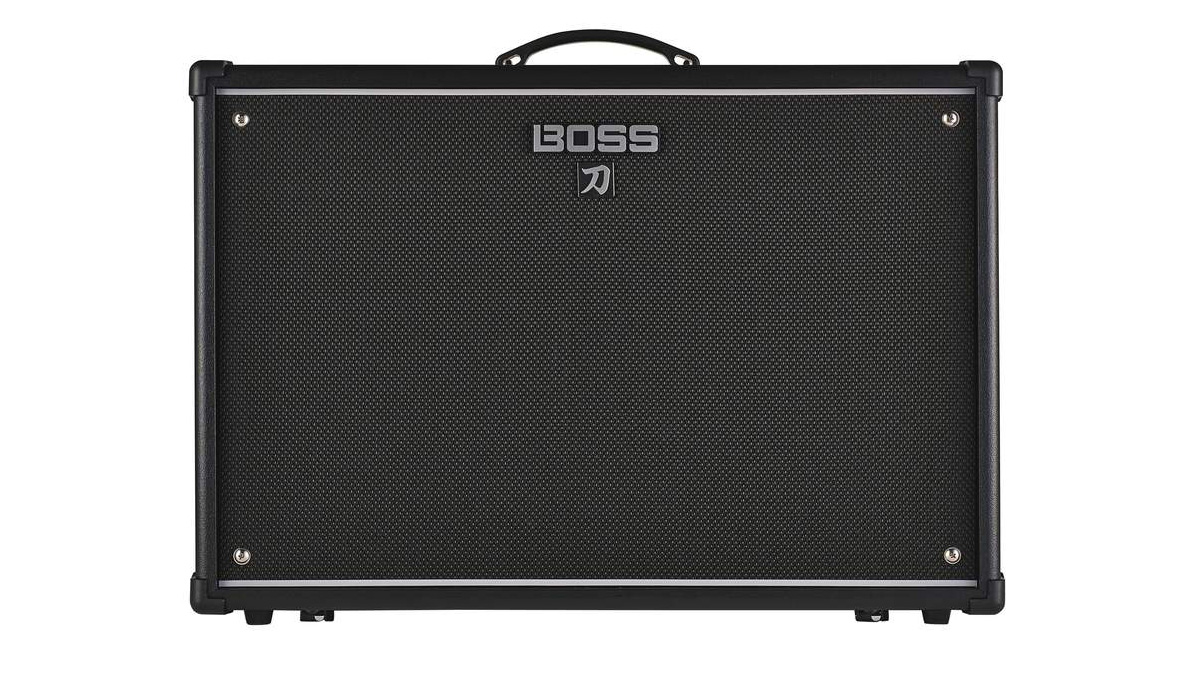MusicRadar Verdict
A great choice for beginners and experienced players alike.
Pros
- +
Portable, powerful and punchy with an impressive, expanded, range of digitally modelled sounds and FX.
Cons
- -
The larger cabinet would be easier to shift with side handles. No MIDI out/Thru.
MusicRadar's got your back
Roland broke with tradition just over a year ago when it unveiled its Katana range of amplifiers and the extraordinary Waza Craft head, using the Boss brand for amplification for the first time.
We were, and still are, mightily impressed with the Katana range, which puts next-generation digital modelling technology into an approachable and surprisingly affordable package. The Katana amps have recently benefitted from a free firmware update, with new effects and functions, so it’s high time we took another look, this time at the largest combo, the 100-watt Katana 100/212.
The Katanas have simple but smart cosmetics, with black vinyl, white piping and a silver stripe to the top and bottom of the speaker grill cloth. The control panel is textured black with white lettering and has a clear, functional layout. There are no LCD displays, just small marker LED’s that tell you which amp sound and effects are in use. This helps give the Katana the reassuring look and feel of a conventional amp, despite the heavyweight technology inside the robust steel box chassis.
The electronics are a mix of discrete and miniature surface-mount components, which are definitely not user-serviceable. However, the Katana is built to handle the rough and tumble of proper gigging so it’s unlikely you’ll ever need to think about the internals.
The loudspeakers are custom-made for the Katana range, with large ceramic magnets ready to push a lot of air. There’s a nice touch on the bottom of the cabinet: a pair of pop-up legs tilt the amp back a few degrees, making it easier to hear from the floor. Overall the Katana looks the part, smart, solid and reliable.
The Katana’s controls are deceptively simple; there’s an amp type knob with five settings including Clean, Crunch, Lead, Brown and Acoustic. The first three are self-explanatory, Brown is a higher gain lead sound derived from Boss’s stunning boutique Waza Craft head, while Acoustic puts the Katana into a special mode that’s ideal for acoustic instruments.
There are familiar knobs for gain, volume, bass, mid and treble, followed by a trio of controls for the Katana’s built-in effects. At the other end of the control panel, there’s a presence and a master volume, together with a power control switch that gives you a choice of 100, 50 or 0.5 watts, together with a standby option.
Want all the hottest music and gear news, reviews, deals, features and more, direct to your inbox? Sign up here.

Above these are five small buttons, four to recall user patches, together with a fifth that puts the Katana into panel, or ‘what you see is what you get’ mode. One functional improvement with the latest software is the number of onboard patches has been doubled, so you can now keep up to eight patches on the amp.
The Katana 100’s rear panel features include a USB socket that doubles as a data and recording connector, a pair of send/return sockets for the effects loop, a headphones/recording output, a MIDI in DIN socket, an aux in and a line out, with a pair of jacks that allow connection of simple channel select footswitches or the GA-FC foot controller, together with an expression pedal.
It all looks simple enough, and indeed it is. However, hidden behind the controls is a seriously powerful tone engine, which is only properly appreciated when you connect the Katana to its software editor, the Boss Tone Studio app.
To begin with there are no less than 58 effects in version 2 of the software, loosely grouped into 15 types; you can load your choice of 15 effects into the Katana and use up to three simultaneously. The first two effects knobs control levels for the Katana’s Booster, Mod, delay and FX groups, with three different effects available from each, selected by prodding the relevant button, which glows red, green or orange to tell you which effect is active. The reverb knob can select three different reverb types from a choice of plate, room, spring, hall and modulation, with new optional delay or delay+reverb modes.
The new effects include models of the MXR Phase 90 and M117 flanger, together with an emulation of the revered Roland SDE-3000 digital delay, considered by more than a few studio techs to be the greatest digital delay ever made. The two effects knobs have half of the knob’s travel reserved for each type, so on knob 1 the first half of the knob’s travel affects boost level, while the second half varies the level of whatever modulation effect is in use. On knob 2, the same thing applies for delay and FX sounds, while the reverb knob operates conventionally, with the full travel given over to the reverb or reverb/delay level.
This is really all the control you need on the amp, however, tweakers needn’t worry about not being catered for, as there’s plenty of flexibility in the Boss Tone Studio app. For example, the SDE-3000 model has no less than seven parameters to play with, while the spring reverb has eight.
Remember the simple bass, mid and treble EQ? Under the hood this expands to a four band, with parametric low and hi-mid, where you can control cut/ boost, sweep frequencies and vary ‘Q’ (how wide or narrow the EQ notch is), and there are now channel and global EQ options. Similarly, the unassuming send/return effects loop jacks on the rear panel can be configured for series or parallel operation, with fully variable send and return levels.
Moreover the loop position can be varied to post-amp or post-reverb, and you can switch it in or out from the GAFC foot-controller, or MIDI. You can choose from three different effects chains and if you opt for the GA-FC foot controller, you can connect up to two expression pedals, one of which controls volume, while the other can be assigned to be a wah, for example.
Sounds
The Katana’s core amp sounds are impressively authentic, from fat, juicy blackface-inspired cleans to responsive tweed-based crunches that are great fun for blues and classic rock, while the lead and brown amp models will satisfy any gain fiend’s desire, especially when you remember there are 20 overdrive and distortion stompbox models to add to the mix.
But it’s not just the variety of tone; the Katana does a very good job of making you - and your audience - think you’re hearing a ‘real’ valve amp with real effects. Whether you use single coils or humbuckers, the dynamic range is wide and the punch of the Katana’s 100-watt output stage is more than enough to cut though on full power.
It’s also very good at effectively mimicking the elusive behaviour of a push-pull valve output stage driven into clipping at low volume with the clever Power Control switch. This drops the output right down to 0.5 watts for home use or recording, if you want to use microphones instead of the excellent cab-simulated direct output.
The Katana will make you and your audience think you’re hearing a ‘real’ valve amp with real effects
Because the Katana uses Roland’s Tube Logic technology, the main amp sounds are also capable of surprising nuance and subtlety, something that wasn’t always the case with earlier COSM-based Boss modelling products. Meanwhile, the Boss Tone Studio app is quick and intuitive with not too much complexity, which makes creating sounds fun, rather than a head- scratching slog.
While the original Katana was impressive enough, this version 2 upgrade has upped the ante, with more onboard patches, new effects and useful functions like cabinet resonance/air options for the line out. In many ways, the Katana has all it takes to be everyone’s ideal modelling amp; it’s simple to use with plenty of great sounds and a tempting price. In this 100-watt 2x12 format, it’s also a formidable live tool that can relegate your pedalboard to the substitute bench, making for a neat, uncluttered stage rig that’s quick to put up and tear down.
There are a few shortcomings: there’s no MIDI out/thru and you have to connect to the editor via USB using a Windows or Mac desktop, which may not always be convenient. There is a mobile version of the app with a wireless connection, but only for the Katana Air compact combo. The online Tone Central Katana portal, accessed via the Boss Tone Studio app, could do with more content, too.
Online stuff aside though, the Katana range is a great choice for beginners and experienced players alike, especially old-school valve amp diehards waiting for a reliable, practical and above all affordable digital alternative to the glass bottle.
- Explore our full round-up of the best guitar amps around
